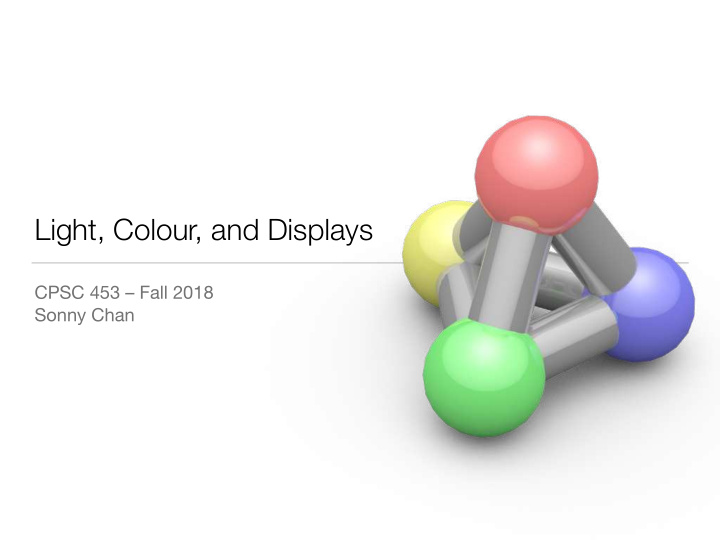



Light, Colour, and Displays CPSC 453 – Fall 2018 Sonny Chan
Announcements • Assignment #1 released! • Written component due Monday, Sept. 17 • Programming component due Tuesday, Sept. 25 • Tutorial sessions have started, hopefully you went! • Ask questions on piazza to get quickest reply • We’ll still answer email or D2L if you prefer
The Written Component • Designed to help you think about the problems before you write your code • Not meant to take up a lot of time • Show your work to get credit! • A single sentence, short paragraph, or couple of equations will usually suffice • Submit scan or (good) photograph of work on D2L
Outline for Today • Light • Colour Ready? • Displays • Resolution • Images
And God said, “Let there be light,” and there was light. –Genesis 1:3
Our first curiosity • What are these “temperature” settings we keep seeing on our cameras and displays? camera settings display settings
What is light?
James Clark Maxwell
[xkcd.org]
[S. Tanzilli] What about photons? Complicated question…
Where does light come from?
Black-Body Radiation • An opaque, non-reflective body in thermodynamic equilibrium emits electromagnetic radiation with a spectrum dependent only on its temperature • Planck’s Radiation Law
How hot is the sun?
Colour
What colour is this ball?
Is it orange?
What exactly do we mean by “orange”?
Human Colour Perception • On our retina, we have two types of photoreceptors, rods and cones, that are sensitive to electromagnetic radiation [xrite.com]
Are we equally sensitive to different visible wavelengths? [webvision.med.utah.edu]
[webvision.med.utah.edu]
[H. Hofer et al. , J. Neuroscience 25(42), 2005] Figure 4. False color images showing the arrangement of L (red), M (green), and S (blue) cones in the retinas of different
Luminous Efficiency • Humans perceive colour differences much more acutely within certain wavelengths! 420nm 450nm 590nm 620nm [courtesy of K. Breeden, Stanford University]
Colour Blindness Ishihara test for cone defect
Perception of Colour • Revisiting our original question: what is “ orange ”?
Do we perceive the same colour? No.
Graphics Displays Not only these…
Graphics Displays … but these too!
What are the primary colours?
Back to Colour Perception • Our goal: stimulate photoreceptors in some combination Or these? How about these?
A Contemporary Liquid Crystal Display
Magnified LCD A display “pixel”
LCDs
Additive Colour Blending
Can we display all perceptible colours?
Colour Matching … isn’t always possible!
Standard RGB Gamut In the CIE colour space
What about these graphics displays?
What is white light?
What kind of light do these things emit?
Colour Reflection [courtesy of K. Breeden, Stanford University]
R+G = ???
Subtractive Colour Blending
Colour Printing How do we control luminance?
Halftones
Primary Colours Was your first grade teacher right?
Resolution
Does your smart phone have the same resolution as your high definition TV ?
What units is resolution measured in?
Human Visual Acuity
Human Visual Acuity Highest visual resolution is about one arc minute (1/60 of a degree) [telescope-optics.net]
So how many pixels do we actually need?
Let’s try a quick exercise How many pixels do we need?
Does your smart phone have the same resolution as your high definition TV ?
What is a digital image?
A record of something we (may) observe?
Digital Images • Two key elements: • Colour - usually R, G, B - can be C, M, Y, K • Resolution - samples, or “pixels”, arranged in a two-dimensional grid - may or may not correspond to pixels on a display
The discipline concerned with generating or manipulating visual imagery using computational devices and methods.
Things to Remember • Light is just another form of electromagnetic radiation • Colour is in the eye of the beholder • Displays are engineered to human visual perception • Resolution is not (necessarily) measured in pixels • Digital images are the goal of computer graphics
Recommend
More recommend